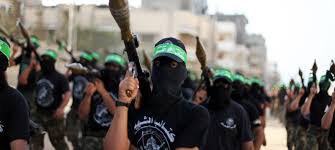OPINION ARTICLES
Conservative Home, May 15
Hamas needs dead Palestinians at Israel's borders

This week's operations, which are larger in scale than any seen previously, could result in greater numbers of Palestinian casualties than we have already seen. If they do, it is important to remember that Hamas is not only the party responsible, but one one that wanted such an outcome in the first place.
2018-05-15 by Rafael Bardaji and Davis Lewin
Hamas, the Islamist terrorist organisation that controls Gaza, claims it will this week mobilise in excess of 100,000 people for the so-called ‘Nakba’ day, which commemorates the creation of Israel, a day after today’s opening of the U.S. Embassy in Jerusalem. Ahead of today’s incidents, the Israel Defense Forces publicly warned that Hamas is looking to perpetrate a massacre.
It is clear that these events are to peaceful demonstrations down Whitehall what heartburn is to a heart attack. Since March, the group has orchestrated large-scale violence in an effort to penetrate Israel, as the latest report from the High Level Military Group, comprised of senior military leaders from democratic nations, shows. These carefully planned military operations – disguised as riots and protests in which crowds mass at border locations – enable armed fighters to approach without detection. While Hamas’ actions have not yet resulted in significant penetrations, success would constitute an extremely serious event. The fence itself lies just a few minutes dash from the closest civilian community.
Infiltration operations masked as civilian protests form the latest part of Hamas’ long-standing strategy of seeking to provoke international outrage, by compelling Israeli actions that can be vilified and criminalised in the court of public opinion. The aim is to create situations which compel the use of force, so that Israeli officials can be accused of wounding or killing innocent Palestinian civilians. During the most recent operations, Hamas staged and filmed incidents which purported to show such actions – with the ‘wounded’ child being let go and running off when the cameras have what they need.
In general, Hamas relies heavily on human shields – often women and children – who are encouraged as well as forced to be present in locations where attacks originate. These are tactics Hamas has worked hard to perfect. The group’s previous innovation was heavy rocket fire at Israeli population centres from civilian locations within Gaza, including mosques and UN installations. Taking its terrorist ingenuity further, it has also constructed an elaborate network of attack tunnels underneath civilian areas around the Gaza border. In both instances, the aim is to provoke Israeli military action that can subsequently be characterised as unprovoked, disproportional, Israeli evil.
However, the creation of large-scale ‘demonstrations’ to attack Israel may be the most effective manifestation of the approach yet. The tactic is more effective than the use of rockets and attack tunnels because the primary targets for these activities — political leaders, international organisations, human rights groups, and the media — find it harder to understand why lethal force might be used against ostensibly peaceful demonstrations.
The environment faced by the Israeli Defence Forces is as challenging as any that a Western army has come up against in recent years. British forces have also faced the terrorist tactics of Islamists. The vile global campaign of lies and hatred that Israel faces on a constant basis, also leaves its personnel with significantly less margin for error than would be enjoyed by our own armies.
As in their reactions to previous bouts of violence, the IDF have adopted a graduated response. They have airdropped thousands of leaflets and used SMS, social media, phone calls, and radio broadcasts to warn the people of Gaza not to gather at the border or approach the fence. They have also contacted Gaza bus company owners and asked them not to transport people to the border. When these appeals were ignored — or at least negated by Hamas’ move to pressure the civilian population — the IDF used tear gas to disperse crowds, before relying on warning shots fired overhead. Only when absolutely necessary and legally permitted, has force been used.
Defensive actions taken by the IDF have resulted in fatalities. Palestinian authorities claim that approximately 50 people have been killed, with hundreds more wounded. However, of those killed, Israel assesses that 80 per cent were either terrorist operatives, or individuals associated with them. While the price paid for these actions has been high — both in human suffering and adverse international opinion — it has undoubtedly saved civilian lives by preventing a major penetration of Israeli territory.
Several high ranking UN and EU officials, in conjunction with human rights groups, have argued that Israel should have acted differently. Yet threats to initiate international investigations, put Israel in front of the International Criminal Court, or invoke universal jurisdiction against Israeli officials responsible for defusing the situation, play into the hands of Hamas. Such moves validate its’ strategy of forcing its own civilians into harms way, and encourage more expansive efforts.
Israel’s friends and allies can assist by countering the propaganda that Hamas seeks to generate, pressuring political leaders, human rights groups, international organisations and the media to avoid false condemnation of Israel, and rejecting demands for one-sided UN investigations and resolutions. Such push-back, preferably accompanied by strong condemnation of Hamas’s violent tactics, could help discourage further use such methods in future. Of course, in the face of a heavily entrenched anti-Israel agenda this is more easily said than done.
This week’s operations, which are larger in scale than any seen previously, could result in greater numbers of Palestinian casualties than we have already seen. If they do, it is important to remember that Hamas is not only the party responsible, but one one that wanted such an outcome in the first place.

